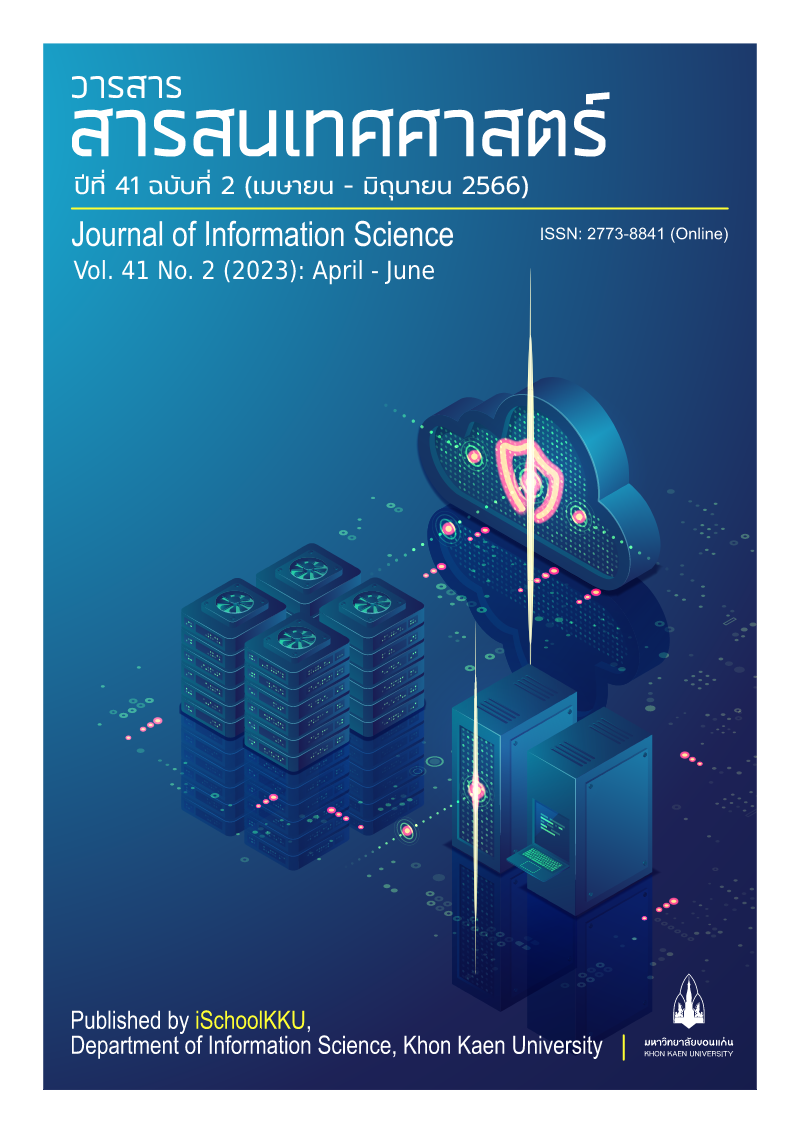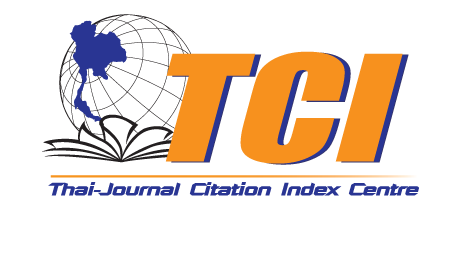ความสัมพันธ์ระหว่างการเปิดรับข่าวสารด้านการเมืองผ่านสื่อใหม่และการรู้เท่าทันข่าวของเยาวชนไทย
DOI:
https://doi.org/10.14456/jiskku.2023.16คำสำคัญ:
การรู้เท่าทันข่าว, การเปิดรับข่าวสารด้านการเมือง, ข่าวสารด้านการเมือง, สื่อสังคม, เยาวชนบทคัดย่อ
วัตถุประสงค์: เพื่อศึกษาความสัมพันธ์ระหว่างการเปิดรับข่าวสารด้านการเมืองและการรู้เท่าทันข่าวของเยาวชน
วิธีการศึกษา: การวิจัยนี้เป็นการวิจัยเชิงปริมาณ ใช้การสุ่มตัวอย่างแบบหลายขั้นตอนจากนักศึกษาระดับปริญญาตรีในภาคตะวันออกเฉียงเหนือ จำนวน 1,200 ราย เครื่องมือที่ใช้ในการเก็บรวบรวมข้อมูล คือ แบบสอบถาม ซึ่งได้ตรวจสอบความเที่ยงตรงเชิงเนื้อหา และทดสอบความเชื่อมั่นของเครื่องมือโดยใช้สูตรการหาค่าสัมประสิทธิ์แอลฟาของครอนบาค ได้ค่าความเชื่อมั่น 0.93
ข้อค้นพบ: เยาวชนเปิดรับข่าวสารด้านการเมืองจากสื่อสังคมออนไลน์ในระดับปานกลาง ซึ่งมีค่าเฉลี่ยมากที่สุด (Mean= 3.10, S.D = 1.19) มีความสามารถในการเข้าถึงข่าวสารด้านการเมืองในระดับมาก (Mean= 3.80, S.D. = 2.98) มีการตรวจสอบความน่าเชื่อถือของสื่อ/ช่องทางการสื่อสาร และมีการตรวจสอบความถูกต้องและความน่าเชื่อถือของข่าวสารในระดับมาก (Mean= 3.59, S.D = 2.91; Mean = 3.60, S.D. = 2.94 ตามลำดับ) และมีความสามารถในการสื่อสารและการมีส่วนร่วมต่อประเด็นข่าวสารด้านการเมืองในระดับมาก (Mean= 3.57, S.D = 1.75) นอกจากนี้ยังพบว่า ความรู้ด้านการเมืองและคลับเฮาส์ของนักการเมืองหรือผู้มีอิทธิพลทางการเมืองมีความสัมพันธ์กับการรู้เท่าทันข่าวของเยาวชน อย่างมีนัยสำคัญทางสถิติที่ระดับ 0.01 โดยมีค่าสหสัมพันธ์สูงที่สุด เท่ากับ 0.579 และ 0.567 ตามลำดับ
การประยุกต์ใช้จากการศึกษานี้: สถาบันการศึกษา โดยเฉพาะระดับมัธยมศึกษาตอนปลายควรมีการเสริมสร้างกิจกรรมรู้เท่าทันการเปิดรับข่าวสารด้านเมืองในรายวิชา “หน้าที่พลเมือง” เพื่อเสริมสร้างการเป็นพลเมืองที่รอบรู้และทันข่าวสาร รวมทั้งเตรียมความพร้อมของเยาวชนก่อนก้าวสู่การเป็นผู้มีสิทธิ์เลือกตั้งครั้งแรกในระดับอุดมศึกษา ขณะเดียวกันรัฐบาล พรรคการเมือง และนักการเมืองควรเลือกใช้ political pages เป็นช่องทางหลักในการสื่อสารทางการเมือง เพราะสามารถเข้าถึงกลุ่มเป้าหมายที่เป็นเยาวชนได้ครอบคลุมทุกลักษณะทางประชากรศาสตร์ ทั้งนี้ การรู้เท่าทันข่าวนับเป็นทักษะจำเป็นที่ต้องพัฒนาควบคู่ไปกับการเปิดรับข่าวสารจากสื่อสังคมออนไลน์ เพื่อส่งเสริมให้เยาวชนใช้ประโยชน์จากการเข้าถึงแหล่งข้อมูลที่หลากหลาย สามารถวิเคราะห์แยกแยะ และตรวจสอบความถูกต้องและความน่าเชื่อถือของข่าวสารได้อย่างรวดเร็วและชาญฉลาด อันจะช่วยลดทอนปัญหาในสถานการณ์ที่สังคมไทยกำลังเผชิญกับความขัดแย้งทางการเมือง และการแบ่งฝักแบ่งฝ่ายในสังคม และเพื่อจะได้ไม่ตกเป็นเหยื่อของบุคคลที่ไม่ประสงค์ดี
Downloads
References
Allam, S.N.S., Hassan, M.S., Ridzuan, A.R., Mohideen, R.S., & Ilyas, I.Y. (2021). How media literacy competency contributes to political participation integrity among young people. International Journal of Academic Research in Business and Social Sciences, 11(4), 814-832.
Ashley, S., Maksl, A., & Craft, S. (2017). News media literacy and political engagement: What’s the connection? Journal of Media Literacy Education, 9(1), 79 – 98.
Beam, M. A., Hutchens, M. J. & Hmielowski, J. D. (2016). Clicking vs sharing: The relationship between online news behaviour and political knowledge. Computers in Human Behavior. 59(1), 215-220.
Broersma, M. (2018). Epilogue: Situating journalism in the digital: A plea for studying news flows, users, and materiality. In: Eldridge S and Franklin B (Eds), The Routledge Handbook of Developments in Digital Journalism Studies. (515-526) New York: Routledge.
de Vreese CH & Neijens, P. (2016). Measuring media exposure in a changing communications environment. Communication Methods and Measures, 10(2-3): 69-80.
Diddi, A., & LaRose, R. (2006). Getting hooked on news: Uses and gratifications and the formation of news habits among college students in an internet environment. Journal of Broadcasting & Electronic Media, 50(2), 193-210.
Hassan, M. S., Sah Allam, S. N., Azni, M. Z., & Khamis, M. H. (2013). Social media and political participation among young people. Journal Sains Sosial, 1(1), 95-114.
Hobbs, R. (2010). News literacy: What works and what doesn't. Presented at the Association for Education in Journalism and Mass Communication (AEJMC) Conference, Denver, Colorado, August 7, 2010.
Inthanon. (2019). News literacy. Retrieved from https://resourcecenter.thaihealth.or.th/files/90/รู้เท่าทันข่าว(NewsLiteracy).pdf
Kesici, A (2018) Do social students use social media more often? Turkish Online Journal of Distance Education, 20(2):121–133.
Khalifa, K. H., Samir, R. & Ebrahim, M. (2021). Uses and gratifications of YouTube platform among young children in Bahrain. International Journal for Media and Mass Communication, 3(2), 183-203.
Kruikemeier, S., Lecheler, S., and Boyer, M.M. (2018). Learning from News on Different Media Platforms: An Eye-Tracking Experiment. Political Communication, 35(1), 75-96.
Ku, K.Y.I., Kong, Q., Song, Y., Deng, L., Kang, Y., & Hu, A. (2019). What predicts adolescents’ critical thinking about real-life news? The role of social media news consumption and news media literacy. Thinking Skills and Creativity, 33, 1-12.
Leonhard, Larissa, Karnowski, Veronika & Kümpel, Anna Sophie. (2020). Online and (the feeling of being) informed: Online news usage patterns and their relation to subjective and objective political knowledge. Computers in Human Behavior, 103, 181–189.
Meijer, I.C., & Kormelink, T.G. (2015). Checking, sharing, clicking, and linking. Digital Journalism, 3(5), 664-679.
Ministry of Digital Economy and Society. (2019). Digital comprehension course for Thai citizens. Retrieved from https://itm.eg.mahidol.ac.th/itm/wp-content/uploads/2020/04/MDES-ONDE-Digital-Literacy-pdf.
Ministry of Higher Education, Science, Research and Innovation. (2018). Report of higher education, science, research, and innovation. (In Thai). Bangkok: Ministry of Higher Education, Science, Research and Innovation.
Ministry of Higher Education, Science, Research and Innovation. (2021). Student information. Retrieved from http://www.info.mhesi.go.th/newinfo/homestat_std.php.
Oeldorf-Hirsch, A. (2018). The role of engagement in learning from active and incidental news exposure on social media. Mass Commun Soc 21(2), 225–247. https://doi.org/10.1080/15205436.2017.1384022.
Office of the Permanent Secretary of the Ministry of Higher Education, Science, Research and Innovation (2020) Student number classified by provinces/regions. Retrieved from https://info.mhesi.go.th/homestat_std.php.
Pires, F., Masanet, M. J., & Scolari, C. A. (2019). What are teens doing with YouTube? Practices, uses, and metaphors of the most popular audio-visual platform. Information Communication and Society, 24(9), 1-17.
Poar, S. D., & Heravi, B. (2020). Information literacy and fake news: How the field of librarianship can help combat the epidemic of fake news. The Journal of Academic Librarianship, 46, 1-8.
Potter W. J. (2019). Seven skills of media literacy. Thousand Oaks, CA: Sage.
Potter, W. J. (2010). The state of media literacy. Journal of Broadcasting & Electronic Media, 54(4), 675-696. https://doi.org/10.1080/08838151.2011.521462.
Radcliffe, D. (2021). Audio chatroom like Clubhouse has become the hot new media by tapping into the age-old appeal of the human voice. Retrieved from https://www.researchgate.net/publication/349608005_Audio_chatrooms_like_Clubhouse_have_become_the_hot_new_media_by_tapping_into_the_age-old_appeal_of_the_human_voice.
Rosenbaum, J.E., Beentjes, J.W.J., & Konig, R.P. (2008). Mapping media Literacy. Key concepts and future directions. Communication yearbook 32. New York: Routledge.
Shi, W., & Nagler, R.H. (2020). Measurement of media exposure. Retrieved from https://www.researchgate.net/publication/345737317_Measurement_of_Media_Exposure.
Slater, M.D. (2004). Operationalizing and analyzing exposure: The foundation of media effects research. Journalism & Mass Communication Quarterly, 81(1), 168–183.
Sunstein, C. (2007). Republic Com 2.0. Princeton, NJ: Princeton University Press.
Sunstein, C. (2018). Republic: Divided democracy in the age of social media. Princeton, NJ: Princeton University Press.
Sveningsson, M. (2015). "It's only a pastime, really": Young people's experiences of social media as a source of news about public affairs. Social Media+Society, 1(2), 1-11.
Swart, J. (2021). Tactics of news literacy: How young people access, evaluate and engage with news on social media. New Media & Society, 1-17.
Tamboer, S.L., Kleemans, M. Molenaar, I. & Bosse, T. (2023) Developing A Model of News Literacy in Early Adolescents: A Survey Study, Mass Communication and Society, 26(1), 74-98.
Tandoc, E.C., Lim, Z.W., & Ling, R. (2018). Defining "fake news". Digital Journalism, 6(2), 137-153.
UNESCO. (2018). A global framework of reference on digital literacy skills for indicator 4.4.2. Retrieved from http://uis.unesco.org/sites/default/files/documents/ip51-global-framework-reference-digital-literacy-skills-2018-en.pdf.
Vanichbuncha, K & Vanichbuncha, T. (2016). SPSS computers and research on social sciences: SPSS for Windows. 29th ed, Bangkok: Samlada Printing.
Wardle, C. (2017). Fake news. It's complicated. First Draft. Retrieved from https://firstdraftnews.org/fake.news-complicated/.
Yamane T. (1973). Statistics: An introductory analysis. 3rd ed., New York: Harper.





